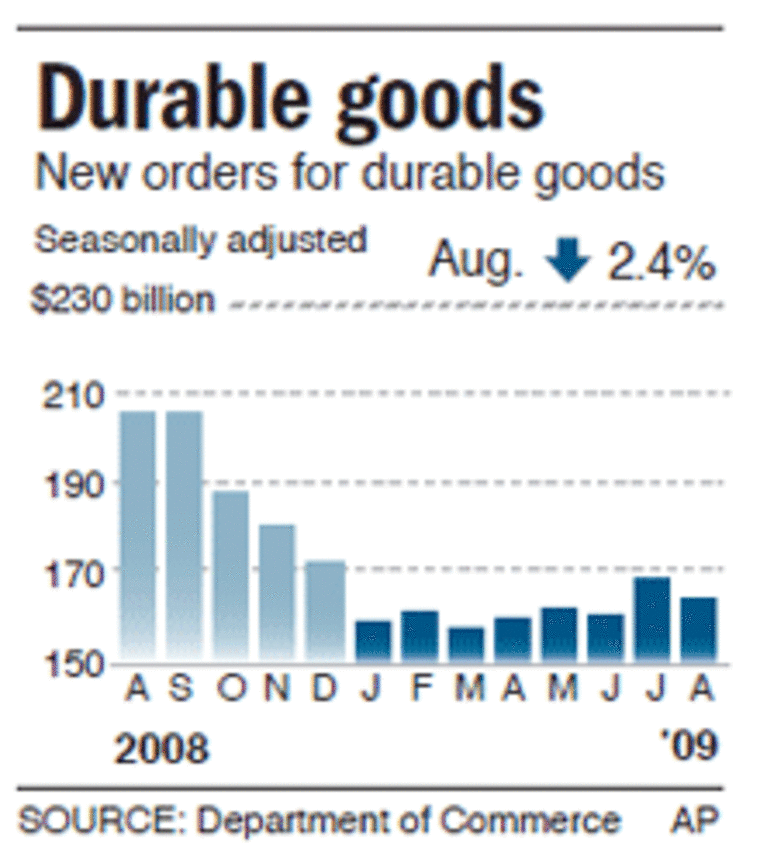Orders for durable goods like aircraft and electronics fell unexpectedly in August, while sales of new homes rose less than expected. The weak reports renewed concerns about whether the economy can sustain a recovery with consumer spending held back by job losses, tight credit and falling home values.
Still, economists said the figures — which follow weaker-than-expected data on existing home sales Thursday — also reflect a volatile economy emerging from the worst recession since the 1930s.
“No one said this would be a smooth recovery,” Benjamin Reitzes, an economist at BMO Capital Markets, wrote in a note to clients. “The data will likely continue to improve in fits and starts.”
Orders for durable goods dropped 2.4 percent in August, after rising a revised 4.8 percent in July, the Commerce Department said Friday. Economists had expected a 0.5 percent increase, according to a survey by Thomson Reuters. It was the second drop in three months in orders for goods expected to last at least three years.
A category known as “non-defense capital goods, excluding aircraft,” a gauge of business investment in machinery and other items, fell 0.4 percent, its second straight drop. It fell 1.3 percent in July.
Some economists said they were concerned that the two straight declines show businesses aren’t confident enough in the recovery to boost their investment in equipment.
Kurt Karl, chief U.S. economist at Swiss Re, said businesses likely are just replacing worn-out equipment, rather than investing in new capacity. Most factories are running at near record-low levels, and extra capacity isn’t needed, he said.
But several economists noted that the three-month average of business spending, which smooths volatility, is rising.
“Business equipment spending is still on track to post a solid gain in the third quarter, but perhaps not quite as robust as earlier thought,” Brian Bethune, chief U.S. financial economist at IHS Global Insight, said in a note to clients.
The department also said new U.S. home sales inched up 0.7 percent last month to a seasonally adjusted annual rate of 429,000 from a downwardly revised 426,000 in July. Economists had expected a pace of 440,000.
Sales have risen 30 percent from the bottom in January, but are off about 70 percent from the peak of four years ago.
The report was the second straight disappointing sign for the U.S. housing market. The National Association of Realtors on Thursday said sales of previously occupied homes, which make up the bulk of the market, dipped 2.7 percent last month.
Builders continue to make severe cuts in prices to attract buyers. The median sales price of $195,200 was 9.5 percent below July’s $215,600. That was the largest monthly drop on records dating to 1963.
The stock market fell in midday trading. The Dow Jones industrial average dropped about 11 points, while broader indexes also dipped.
Orders for commercial aircraft and parts, an especially volatile category, sank 42.2 percent in August after nearly doubling in July.
Excluding aircraft and other transportation goods, orders were flat in August — below analysts’ expectations of a 0.5 percent rise. Transportation goods orders dropped 9.3 percent.
The Boeing Co. said earlier this month that its August orders fell 11 percent, as weaker demand for air travel forces airlines to scale back plans to buy new planes.

The Chicago-based airplane maker also said commercial jet deliveries tumbled 22 percent last month compared with August 2008. Still, Boeing says it remains on track to deliver 480-485 planes this year, up from 375 in 2008.
Autos and auto parts orders posted a 0.4 percent gain in August, after rising 1.6 percent in July, according to the government data. The sector received a major boost last month from the Cash for Clunkers program, which gave consumers rebates of up to $4,500 for trading in older cars for newer, more fuel-efficient models. The program, which ended last month, boosted auto sales 30 percent in August.
Several other categories posted weak results. Orders for computers and electronic products dropped 0.7 percent, after rising for two straight months. Electrical equipment and appliance orders fell 0.5 percent, after jumping 4.2 percent in July.
Still, other recent measures of manufacturing output have been positive. The Federal Reserve said last week that industrial production rose for the second straight month in August. And the Institute for Supply Management, a trade group, said earlier this month that its gauge of manufacturing activity signaled growth in August for the first time in 19 months.